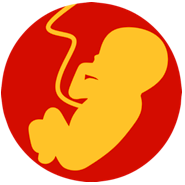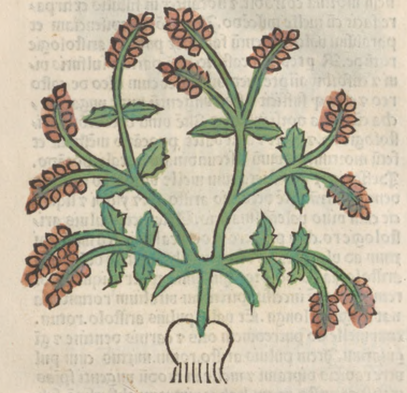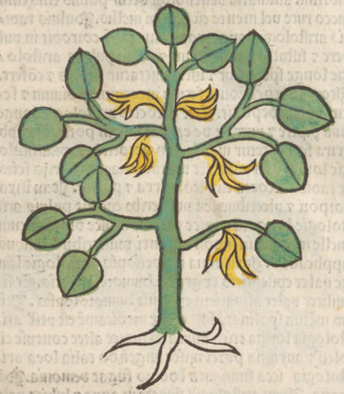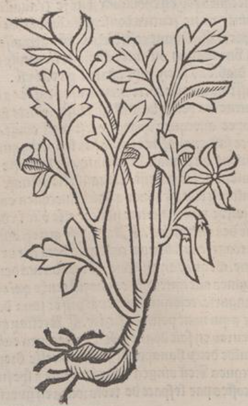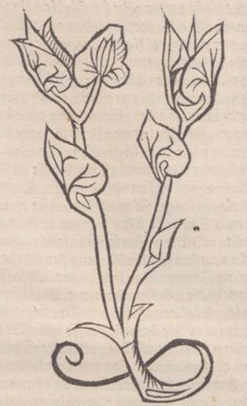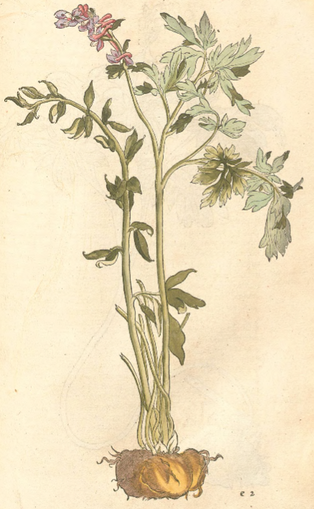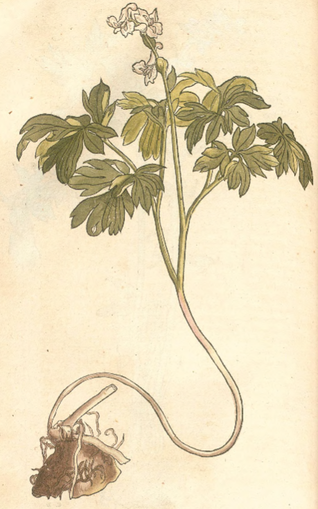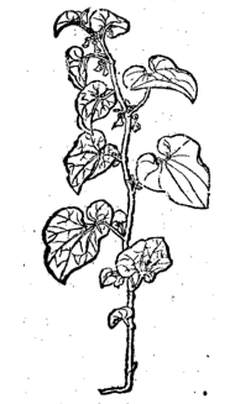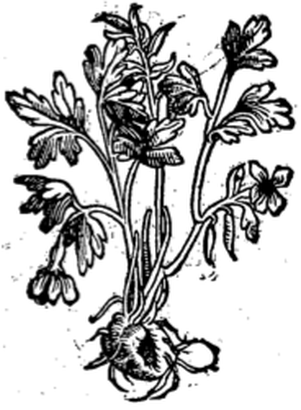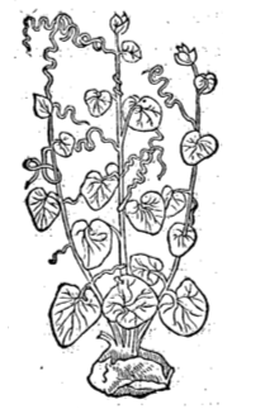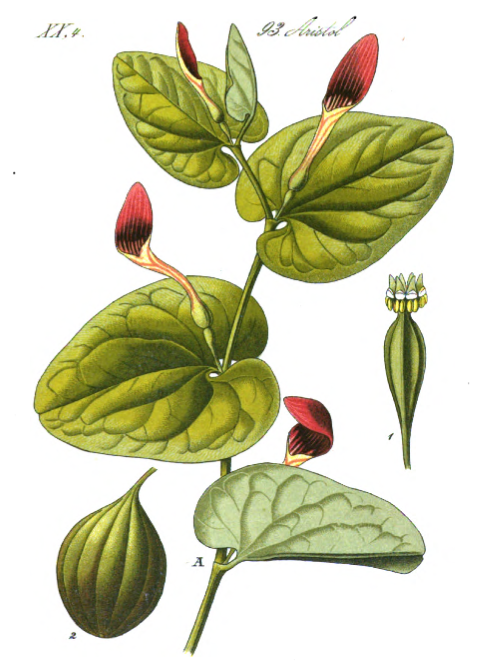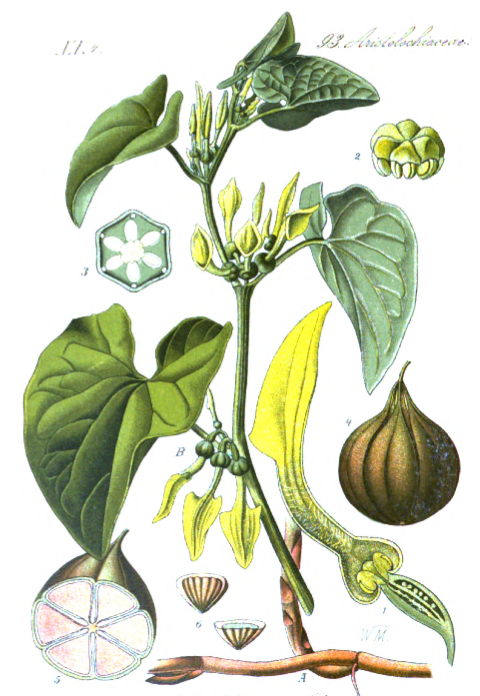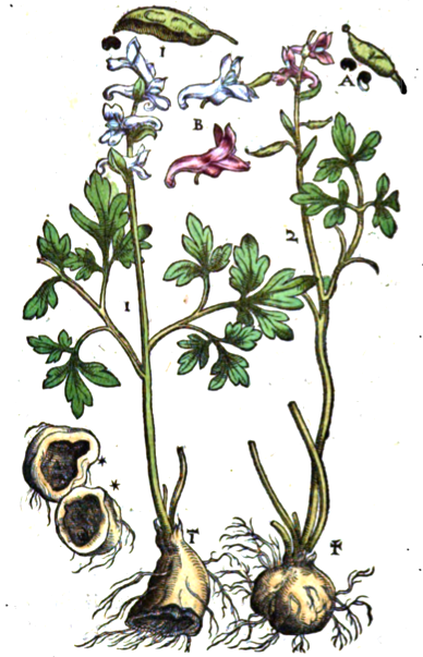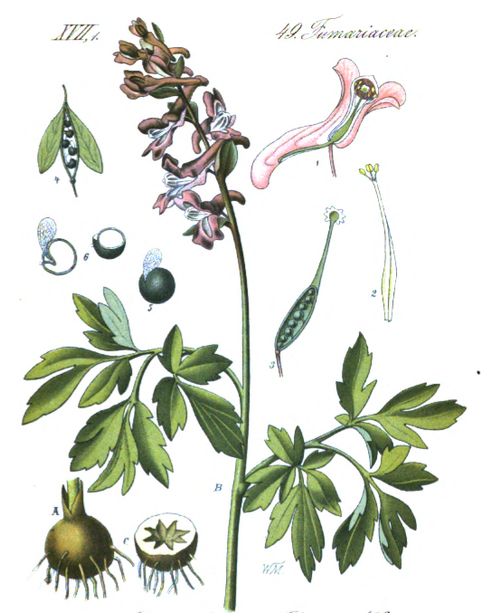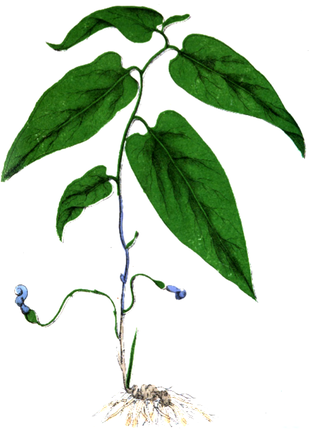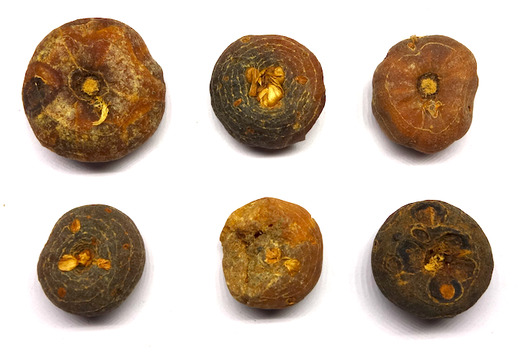Sentry Page Protection
Round Birthwort. Long Birthwort
Ortus sanitatis, Cube, Johann von, 1501
Ortus sanitatis, Cube, Johann von, 1501
Round Birthwort Long Birthwort
Herbarum viuae eicones, Otto Brunfels, 1530
Herbarum viuae eicones, Otto Brunfels, 1530
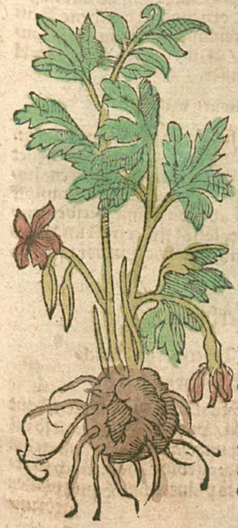
Aristolochia clematis (Kurtzes Handtbuchlein, Ryff, 1599)
As can be seen above it is the same as the 'Official Birthwort',
shown above. However, when compared with the picture of
A. clematis below, it appears the 'Official Birthwort' may have
been 'Bulbous Fumitory' (see below), which was an
accepted substitute for Birthwort.
A. rotunda A. clematis
Flora von Deutschland (21), Kohler, 1885
Flora von Deutschland (21), Kohler, 1885
Virginian Snakeroot
Materia Medica Botanica, Wellman, 1845
Materia Medica Botanica, Wellman, 1845
Virginian Snakeroot
Notes on Pharmacognosy, Otto Augustus Wall, 1902
Notes on Pharmacognosy, Otto Augustus Wall, 1902
Round Birthwort root
(Calcutta Unani College, Adam, 2019)
(Calcutta Unani College, Adam, 2019)
Botanical name:
Aristolochia spp.
In the West:
i. Long Birthwort root
ii. Round Birthwort roots
Various other Birthworts were used including, Small and Clematis-like (A. clematis), the latter has been used for Long Birthwort.
Ayurveda and Unani use A. bracteolata (syn. A. bracteata), A. indica, A. longa, as Zarawand, used as an emmenagogue. These are used the same as Birthwort in the West.
In TCM, several species of Aristolochia are used:
i. Ma Dou Ling: fruit of A. debilis, A. contorta
ii. Qing Mu Xiang: root of A. debilis, A. contorta
iii. Guang Fang Ji: root of A. fangchi
iv. Guan Mu Tong: caulis of A. manshuriensis
v. Xun Gu Feng: herb of A. mollissima
Tibetan Medicine uses Ba le ka derived from A. moupinensis, A. contorta (A. griffithii in Bhutan)
Virginian Snakeroot (syn. A. serpentina, Serpentaria virginica) was introduced from the U.S.
Parts used:
Roots
'the spherical type is better for medical uses' (Galen)
TCM also use other parts of the Aristolchias (see below)
Temperature & Taste:
Regarded as Hot in the West, Cold in TCM; very dry. Pungent. Toxic
Cephalic, Hepatic and Pulmonic, attenuate and open
Classifications:
2B ATTENUATER. 2D ATTENUATERS OF CONGEALED BLOOD. 2F. PURIFYING. 2K. RESOLVENT. 2M. DRAWING. 2T. GLUTINATE
2U. SUPPURATIVE. 2W. SARCOTIC. 2Z. CICATRIZING
3C. ALEXIPHARMIC. 3F. LITHONTRIPTIC. 3G. EMMENAGOGUE. 3I. APHRODISIAC. 3K. EXPECTORANT. 3L. ANTI-TUSSIVE
4i. UTERINE
Aristolochia spp.
In the West:
i. Long Birthwort root
ii. Round Birthwort roots
Various other Birthworts were used including, Small and Clematis-like (A. clematis), the latter has been used for Long Birthwort.
Ayurveda and Unani use A. bracteolata (syn. A. bracteata), A. indica, A. longa, as Zarawand, used as an emmenagogue. These are used the same as Birthwort in the West.
In TCM, several species of Aristolochia are used:
i. Ma Dou Ling: fruit of A. debilis, A. contorta
ii. Qing Mu Xiang: root of A. debilis, A. contorta
iii. Guang Fang Ji: root of A. fangchi
iv. Guan Mu Tong: caulis of A. manshuriensis
v. Xun Gu Feng: herb of A. mollissima
Tibetan Medicine uses Ba le ka derived from A. moupinensis, A. contorta (A. griffithii in Bhutan)
Virginian Snakeroot (syn. A. serpentina, Serpentaria virginica) was introduced from the U.S.
Parts used:
Roots
'the spherical type is better for medical uses' (Galen)
TCM also use other parts of the Aristolchias (see below)
Temperature & Taste:
Regarded as Hot in the West, Cold in TCM; very dry. Pungent. Toxic
Cephalic, Hepatic and Pulmonic, attenuate and open
Classifications:
2B ATTENUATER. 2D ATTENUATERS OF CONGEALED BLOOD. 2F. PURIFYING. 2K. RESOLVENT. 2M. DRAWING. 2T. GLUTINATE
2U. SUPPURATIVE. 2W. SARCOTIC. 2Z. CICATRIZING
3C. ALEXIPHARMIC. 3F. LITHONTRIPTIC. 3G. EMMENAGOGUE. 3I. APHRODISIAC. 3K. EXPECTORANT. 3L. ANTI-TUSSIVE
4i. UTERINE
Uses:
Western Use of Birthworts
1. Clears Phlegm, Stops Cough and Wheezing:
-good for ‘Tartarous Mucilage’ of the Lungs; it expectorates Phlegm
2. Moves Qi, Opens Obstructions, Stops Pain:
-Cramps, Convulsions, Epilepsy (Round)
-Pain of the Sides and Spleen (Round)
3. Clears Damp, Promotes Urine
-promotes Urine; Edema (Long)
4. Moves the Blood, Promotes Menstruation and Labor:
-promote Menstruation, clears Afterbirth (Round is strongest)
-traditionally to promote Labor
-ripens and breaks Tumors internally (Long and Round)
5. Resists Poison:
-various Poisons and Venomous bites
6. Externally:
-expels Poison
-externally, a wash is used for the Itch, and cleanses Wounds, and heals them
-Distilled Water useful against Creeping Ulcers, pustules of the Genitals, cloths being soaked in and applied (Pemell, 1652)
Ba le ka (Tibetan Birthwort)
1. Pneumonitis, hepatitis, intestinal inflammation, spasms, excess impure blood and complications due to blood disorders (Drungtso)
VIRGINIAN SNAKE ROOT:
1. Resists Poison:
-primarily for Poison, venomous bites, especially Snake Bite
-Burning Fevers, Pestilential Fever, all epidemic diseases; Measles, Small Pox, all Spotted Fevers
-Poison sores and wounds; Wounds made with poison arrows
Note:
1. Aristolchia longa is stronger as an emmenagogue; A. rotunda is better to clear Phlegm. However, some sources (including Galen) said Round Birthwort is generally stronger for all indications.
2. Chinese Aristolochia Qing Mu Xiang is perhaps most similar to the Western Birthworts. However, it is not noted as an emmenagogue or for its effects of promoting Labor, despite this being the reason for the names given in the West.
3. 'All the Birthworts are cephalick, thoracick, uterine, vulnerary, and alexipharmic, The round is universally allowed to be more attenuating than the long; and the long, on the contrary, is more powerfully detersive than the round; Wherefore, in Affections of the Breast from thick Humours, in flatulencies and colick Pains, in, Obſtructions of the Spleen and Womb, and in Ruptures of Vessels to dissolve grumous Blood, round Birthwort ought to be used; for it draws off various Excrements, by the Menses, Urine, and Emunctories of the Skin. On the other Hand, in Wounds and sordid Ulcers, in the Scab and: other cutaneous Diseases, long Birthwort is preferable, being used in Lotions; and in the same Form is good to derterge Fistulas. But the principal and most excellent Virtues of both consist in promoting the menstrual Purgations, and in cleansing the Womb after Delivery, and in this Account they are commended by Hippocrates in his book on the Diseases of Women. (A Treatise on Foreign Drugs, Geoffroy and Thicknesse, 1749)
4. As these are forbidden due to their toxicity (aristolchic acid), suitable substitutes can be chosen from below based on the requirements of the formula.
Dose:
6 grains– 1 scruple in powder (up to 1 dram was used);
Decoction: 3–6 grams (1–2 drams, up to 3 drams was used)
Correctives:
1. Honey
2. Black Pepper
Substitutes:
1. Virginian Snakeroot (A. serpentaria) was accepted as a substitute for Indian Birthwort (Waring)
2. Round Birthwort: Zedoary and a third part Mace and half part Costus (Avicenna)
3. Long Birthwort: Zedoary with half part Black Pepper (Avicenna)
4. Mesue used Rhubarb root (equal or half weight) for Birthwort
5. Arum root can be used for Round Birthwort when used to clear Phlegm.
6. Bulbous Fumitory (Corydalis bulbosa) was said to commonly supply the market for ‘Round Birthwort’. This suggests that when Birthwort is used i Blood-moving formulas, Corydalis Yan Hu Suo of TCM would be a good substitute.
7. Angelica or Galangal have been recommended as substitutes for Virginian Snakeroot
8. Stephania tetrandra (Han Fang Ji) and Cocculus orbiculatus (Mu Fang Ji) are accepted substitutes for Guang Fang Ji. (A. fangchi) in TCM; the former is stronger for Damp-Heat Edema and Red Swollen Joints; the latter for Wind-Damp type Joint Pain.
9. Akebia Mu Tong or Clematis Chuan Mu Tong are used for Guan Mu Tong (A. manshuriensis) in TCM.
10. In some Tibetan formulas where Ba le ka is listed, Tig ta (Swertia) is substituted.
Preparation:
A method to reduce Aristolchic acid content
A method reportedly used to reduce aristolchic acid content by 99% from Herbal Medicine, and thus making it within acceptable limits was achieved by soaking the material in a solution of Sodium bicarbonate for 3 days, rinsing well with clean water, then vinegar stir-frying.
Other researchers achieved 93% reduction in aristolchic acid of Aristolchia spp. by simply soaking in Sodium bicarbonate solution for 3 days. (see here)
1. Aristolchia longa is stronger as an emmenagogue; A. rotunda is better to clear Phlegm. However, some sources (including Galen) said Round Birthwort is generally stronger for all indications.
2. Chinese Aristolochia Qing Mu Xiang is perhaps most similar to the Western Birthworts. However, it is not noted as an emmenagogue or for its effects of promoting Labor, despite this being the reason for the names given in the West.
3. 'All the Birthworts are cephalick, thoracick, uterine, vulnerary, and alexipharmic, The round is universally allowed to be more attenuating than the long; and the long, on the contrary, is more powerfully detersive than the round; Wherefore, in Affections of the Breast from thick Humours, in flatulencies and colick Pains, in, Obſtructions of the Spleen and Womb, and in Ruptures of Vessels to dissolve grumous Blood, round Birthwort ought to be used; for it draws off various Excrements, by the Menses, Urine, and Emunctories of the Skin. On the other Hand, in Wounds and sordid Ulcers, in the Scab and: other cutaneous Diseases, long Birthwort is preferable, being used in Lotions; and in the same Form is good to derterge Fistulas. But the principal and most excellent Virtues of both consist in promoting the menstrual Purgations, and in cleansing the Womb after Delivery, and in this Account they are commended by Hippocrates in his book on the Diseases of Women. (A Treatise on Foreign Drugs, Geoffroy and Thicknesse, 1749)
4. As these are forbidden due to their toxicity (aristolchic acid), suitable substitutes can be chosen from below based on the requirements of the formula.
Dose:
6 grains– 1 scruple in powder (up to 1 dram was used);
Decoction: 3–6 grams (1–2 drams, up to 3 drams was used)
Correctives:
1. Honey
2. Black Pepper
Substitutes:
1. Virginian Snakeroot (A. serpentaria) was accepted as a substitute for Indian Birthwort (Waring)
2. Round Birthwort: Zedoary and a third part Mace and half part Costus (Avicenna)
3. Long Birthwort: Zedoary with half part Black Pepper (Avicenna)
4. Mesue used Rhubarb root (equal or half weight) for Birthwort
5. Arum root can be used for Round Birthwort when used to clear Phlegm.
6. Bulbous Fumitory (Corydalis bulbosa) was said to commonly supply the market for ‘Round Birthwort’. This suggests that when Birthwort is used i Blood-moving formulas, Corydalis Yan Hu Suo of TCM would be a good substitute.
7. Angelica or Galangal have been recommended as substitutes for Virginian Snakeroot
8. Stephania tetrandra (Han Fang Ji) and Cocculus orbiculatus (Mu Fang Ji) are accepted substitutes for Guang Fang Ji. (A. fangchi) in TCM; the former is stronger for Damp-Heat Edema and Red Swollen Joints; the latter for Wind-Damp type Joint Pain.
9. Akebia Mu Tong or Clematis Chuan Mu Tong are used for Guan Mu Tong (A. manshuriensis) in TCM.
10. In some Tibetan formulas where Ba le ka is listed, Tig ta (Swertia) is substituted.
Preparation:
A method to reduce Aristolchic acid content
A method reportedly used to reduce aristolchic acid content by 99% from Herbal Medicine, and thus making it within acceptable limits was achieved by soaking the material in a solution of Sodium bicarbonate for 3 days, rinsing well with clean water, then vinegar stir-frying.
Other researchers achieved 93% reduction in aristolchic acid of Aristolchia spp. by simply soaking in Sodium bicarbonate solution for 3 days. (see here)
Main Combinations:
1. Epilepsy, Round Birthwort with Peony seed
2. Arthritis:
i. Round Birthwort with Germander, Ground pine, Centaury, Sage, Betony, Gentian, Guaiacum, powder and give in hydromel (Pemell, 1652)
ii. Long Birthwort with Germander, Ground pine, Centaury, Gentian, Agaric, St. Johns wort (Antidote of Seven Things)
3. Pills for Epilepsy, Paralysis, Shortness of Breath, chronic Cough, hardness of the Liver, Amenorrhea: Round Birthwort (1 oz.), Gentian, Myrrh (3 drams), Aloes, Cinnamon (half oz.), Ginger (1 dram), form a pill mass with oil of sweet Almond. Dose: 1–1.5 drams. (Pemell, 1652)
4. Stomach pain, with Round Birthwort, Aniseed, Caraway, Agaric troches, Camomile, Centaury
5. Pain in the sides, Birthwort with Myrrh
6. To promote Menstruation, expel the afterbirth or a dead fetus, Birthwort, Myrrh and Black Pepper (Pliny)
7. To cleanse impurities from the Womb, Birthwort with Myrrh, White Pepper (Pemell, 1652)
8. To clear the Afterbirth, Round Birthwort (3 drams), Cinnamon (1 dram), Saffron (1 scruple), with Syrup of Mugwort form an Electuary. Dose: 1 dram, repeated after 4 hours. (Tractatus de materia medica, Geoffroy, 1741)
9. Uterus pain, wash the area with a decoction of Long Birthwort. (The Secrets of Alexis, 1615)
10. Difficulty Breathing, take Round Birthwort powder. (The Secrets of Alexis, 1615)
11. Strumous swellings of the throat: Round birthwort, Radish root (1 dram), Rue (2 drams), Figwort (4 drams), Aniseed (2 drams), Ginger (1 dram), Turbith, Senna (3 drams each); powder, add an equal amount of sugar. Take a spoonful every morning with warm water. (Pemell, 1652)
12. To promote birth, round birthwort 2 drams, decoct in water or posset drink
13. Worms: Round Birthwort, Wormwood, Southernwood, Tansy, Savin, prepared Black Hellebore, Aloe
Major Formulas
Theriac of Four Ingredients (Diatessaron)
Electuary for Asthma (Gereonis)
Medicament Strong Against Asthma
Powder for Gout of the Duke of Portland
Antidote of Seven Things (Paulus Aegineta)
Cautions:
Obsolete; Prohibited because of the aristolchic acid content. Use substitute medicines (above).
The Birthworts are, however, still used in Traditional Medicine systems. In TCM, when they are used Liver and Kidney function tests every few weeks (as is done while taking some western medicines). If Liver enzymes or Kidney function begins to be adversely affected, medication is stopped. Ayurveda and Unani medicine likewise still uses Aristolchia rotunda.
It is to be noted that the majority of times Aristolchia is used in Traditional medicine is in large compounds where it makes a small percentage of the total (usually 5% or less). In these circumstances it can most probably be used quite safely if breaks in treatment are taken.
Toxicity
1. Aristolchic acid is very toxic, damaging the Liver and Kidneys. It is also mutagenic and carcinogenic.
2. Research in Taiwan hospitals found a staggering 78% of Liver Tumor patients had exposure to aristolchic acid which was said to "indicate strongly that aristolochic acid was one of the causes of these cancers" (see here)
3. LD50 for oral administration of Aristolchia Xun Gu Feng via decoction in mice is 64.11 g/kg
Main Preparations used:
Obsolete; Prohibited because of the aristolchic acid content. Use substitute medicines (above).
The Birthworts are, however, still used in Traditional Medicine systems. In TCM, when they are used Liver and Kidney function tests every few weeks (as is done while taking some western medicines). If Liver enzymes or Kidney function begins to be adversely affected, medication is stopped. Ayurveda and Unani medicine likewise still uses Aristolchia rotunda.
It is to be noted that the majority of times Aristolchia is used in Traditional medicine is in large compounds where it makes a small percentage of the total (usually 5% or less). In these circumstances it can most probably be used quite safely if breaks in treatment are taken.
Toxicity
1. Aristolchic acid is very toxic, damaging the Liver and Kidneys. It is also mutagenic and carcinogenic.
2. Research in Taiwan hospitals found a staggering 78% of Liver Tumor patients had exposure to aristolchic acid which was said to "indicate strongly that aristolochic acid was one of the causes of these cancers" (see here)
3. LD50 for oral administration of Aristolchia Xun Gu Feng via decoction in mice is 64.11 g/kg
Main Preparations used:
The Chinese Aristolchia:
MA DOU LING (Cool, Bitter. Toxic)
A. debilis, A. contorta fruit
1. Clears Phlegm, Stops Cough and Wheezing:
-cough or wheezing from Lung heat
2. Clears Heat, Purges the Intestines:
-pain and swelling of the anus; accumulation of Heat in the intestines
Dose: 3–9 grams in decoction
QING MU XIANG (Cold, Bitter. Toxic)
A. debilis, A. contorta root
1. Moves Qi, Stops Pain:
-epigastric and hypochondriac pain and distention
-Diarrhea
2. Resists Poison:
-Toxic Sores
-poison including Snake Bites
Dose: 3–9 grams in decoction
GUANG FANG JI (Cold, Bitter. Toxic)
Aristolochia fangchi root
1. Clears Wind-Damp, Reduces Heat:
-arthritic or muscular pain from wind-damp-heat
2. Clears Damp, Promotes Urine:
NOTE: Xun Gu Feng is used similarly for Wind-Damp pain, but is not as strong
Dose: 3–9 grams in decoction
Guan Mu Tong (Cold. Bitter. Toxic)
A. manshuriensis caulis
1. Clears Damp, Promotes Urine:
-Dysuria from Damp-Heat with burning
Dose: 3–6 grams in decoction
Xun Gu Feng (Neutral. Pungent, Bitter. Toxic)
A. mollissima herb
1. Clears Wind-Damp, Opens the Channels, Eases pain:
-Arthritic and Rhuematic pain and numbness
-spasms, cramps, pain from Trauma
Dose: 10–15 grams
A. debilis, A. contorta fruit
1. Clears Phlegm, Stops Cough and Wheezing:
-cough or wheezing from Lung heat
2. Clears Heat, Purges the Intestines:
-pain and swelling of the anus; accumulation of Heat in the intestines
Dose: 3–9 grams in decoction
QING MU XIANG (Cold, Bitter. Toxic)
A. debilis, A. contorta root
1. Moves Qi, Stops Pain:
-epigastric and hypochondriac pain and distention
-Diarrhea
2. Resists Poison:
-Toxic Sores
-poison including Snake Bites
Dose: 3–9 grams in decoction
GUANG FANG JI (Cold, Bitter. Toxic)
Aristolochia fangchi root
1. Clears Wind-Damp, Reduces Heat:
-arthritic or muscular pain from wind-damp-heat
2. Clears Damp, Promotes Urine:
NOTE: Xun Gu Feng is used similarly for Wind-Damp pain, but is not as strong
Dose: 3–9 grams in decoction
Guan Mu Tong (Cold. Bitter. Toxic)
A. manshuriensis caulis
1. Clears Damp, Promotes Urine:
-Dysuria from Damp-Heat with burning
Dose: 3–6 grams in decoction
Xun Gu Feng (Neutral. Pungent, Bitter. Toxic)
A. mollissima herb
1. Clears Wind-Damp, Opens the Channels, Eases pain:
-Arthritic and Rhuematic pain and numbness
-spasms, cramps, pain from Trauma
Dose: 10–15 grams
Click the Tabs above for more information on this Medicine
Pliny on Aristolochia:
|
'In the number of the most celebrated plants is the aristolochia, which would appear to have derived its name from females in a state of pregnancy, as being Αριστολοχία. [most excellent for pregnancy]. Among us, however, it is known as the " malum terra," or apple of the earth, four different varieties of it being distinguished. One of these has a root covered with tubercles of a rounded shape, and leaves of a mixed appearance, between those of the mallow and the ivy, only softer and more swarthy. The second kind is the male plant, with an elongated root some four fingers in length, and the thickness of a walking stick. A third variety is extremely thin and long, similar to a young vine in appearance: it has the most strongly marked properties of them all, and is known by the additional names of "clematitis," and "cretica." All these plants are the colour of boxwood, have a slender stem, and bear a purple flower and small berries like those of the cape : the root is the only part that is possessed of any virtues.
'There is also a fourth kind, the name given to which is "plistolochia;" it is more slender than the one last mentioned, has a root thickly covered with filaments, and isabout as thick as a good-sized bulrush: another name given to it is "polyrrhizos." The smell of all these plants is medicinal, but that of the one with an oblong root and a very slender stem, is the most agreeable: this last, in fact, which has a fleshy outer coat, is well adapted as an ingredient for nardine unguents even. They grow in rich champaign soils, and the best time for |
gathering them is harvest; after the earth is scraped from off them, they are put by for keeping.
'The aristolochia that is the most esteemed, however, is that which comes from Pontus; but whatever the soil may happen to be, the more weighty it is, the better adapted it is for medicinal purposes. The aristolochia with a round root is recommended for the stings of serpents, and that with an oblong root ... [indetermined] But in this is centred its principal reputation; applied to the uterus with raw beef, as a pessary, immediately after conception, it will ensure the birth of male issue, they say. The fishermen on the coasts of Campania give the round root the name of "poison of the earth ;" and I myself have seen them pound it with lime, and throw il into the sea; immediately on which the fish flew towards it with surprising avidity, and being struck dead in an instant, floated upon the surface. 'The kind that is known as " polyrrhizos," is remarkably good, they say, for convulsions, contusions, and falls with violence, an infusion of the root being taken in water: the seed, too, is useful for pleurisy and affections of the sinews. It is considered, too, to be possessed of warming and strengthening properties, similar to those of satyrion [Orchis], in fact. (The Natural History of Pliny, trans. by Bostock and Riley, Vol. 5, 1856) |

